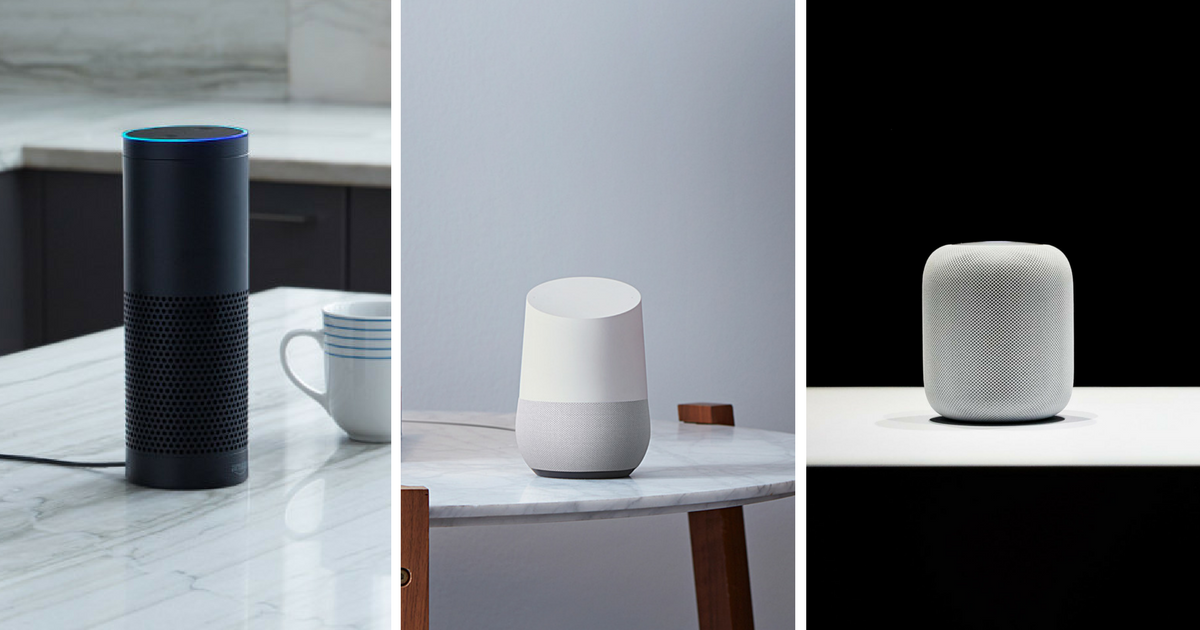With HomePod on the Horizon, Which Home Assistant is Best?

Unveiling its HomePod at the recent Worldwide Developer Conference, Apple probably didn’t surprise anyone by stepping into the home assistant game. With Amazon and Google having established the market, it was only a matter of time for the company to assert a place for itself among the competition. But with yet another option stepping into the fray, consumers are scratching their heads: which home assistant is best?
Let’s dive into each device’s pros and cons to determine the best home assistant for your needs. Spoiler alert: there is no singular “best” device. Basically, the one that’s right for you is dependent on what functions you prioritize.
Finding the Voice Assistant That’s Right for You
First, the device that’s right for you might bear in some way on which voice assistant you already use. Home Pod’s Siri is already right at home on iOS, while Google Assistant has been rolling out to Android devices. If you own a smartphone, you’ve probably experimented with one of these assistants already. Less ubiquitous is Amazon’s Alexa, the voice assistant who powers Echo devices. Unless you’re a power-user of the Amazon app, you probably haven’t spoken to her.
Aside from which home assistant fits within your app ecosystem more—Siri, for example, is simply more accessible than competing assistants for iPhone users. Each assistant has areas where they shine. Google Assistant is amazing when it comes to contextual awareness throughout a conversation. Google has also introduced a sort of marketplace of skills that users can install to make the home assistant more useful.
Alexa similarly offers a vast amount of skills and commands. Also, it has the added bonus of integration into Amazon’s marketplace. Users can request a purchase and Alexa will carry it out for them. If you frequently buy from Amazon, you might appreciate how easy the Echo makes purchasing what you need when you need it.
Siri has always occupied a space in-between. She never did an overwhelmingly great or terrible job with a query. That said, Siri’s about to get better in one area upon release of the HomePod: music trivia. When listening to music with the device, users can ask context-sensitive questions (“Who’s playing the drums on this track?”) and Siri will respond. Her awareness of what’s playing is impressive, and a breakout feature.
Each Home Assistant Offers Different Functionality
When it comes to functionality, let’s start with music. While Amazon Echo and Google Home offer a handful of sources to stream music from. HomePod only offers Apple Music. This is fine enough for Apple Music subscribers, but really isn’t helpful for anyone else. Because the HomePod is first and foremost a music speaker (more on that below). This is a serious limitation.
The Apple HomePod is similarly limited in other functionality compared to its competitors. The only third-party integration it offers is through HomeKit. This offers less than Amazon and Google’s growing list of skills. But at least it can, say, turn off your lights and close your blinds.
Assessing the Home Assistant Prices & Marketing Angles
It’s important to note that unlike the Amazon Echo or Google Home, Apple’s HomePod seems to be marketed primarily as a high-end speaker primarily, with Siri taking the backseat. Its biggest selling point is the actual hardware. Using sensors, the speaker recognizes its place in a room to deliver a rich sound. While the jury is out on sound quality until we can hear it, the focus on audio over assistance might make Home Pod the obvious choice for audiophiles with a big budget.
Echo and Google Home, meanwhile, are designed primarily for providing hands-free assistance throughout the home. The Echo Dot shines in its affordability. Since these devices are all about easy access to information, the low cost of placing an Echo device in every major room is definitely an advantage. Due to its hefty price, it’s tough to imagine the average user buying multiple HomePods for their home.
Google Home sits somewhere in-between when it comes to price, but it is fashionable. Its visual design (and different color options) show that the team carefully considered the device as an object that should look visually pleasing with any interior design theme.
The Bottom Line: Which Home Assistant is Best for You?
Here are the simple pros and cons for each device. Amazon Echo is the best home assistant for those looking for a sophisticated, hands-free home assistant on a budget. Alexa is also an obvious choice to Amazon Prime customers who make frequent purchases on its marketplace.
If you care less about home assistant functionality and are more focused on audio quality, look into HomePod if your budget allows. Unfortunately, the need to stream via Apple Music and limited functionality through HomeKit pretty much require that you’re already within Apple’s ecosystem.
Finally, Google Home offers pretty much the functionality Amazon Echo minus Amazon access. But is the best home assistant when it comes to conversational UI thanks to contextual awareness. It’s a bit more expensive, but looks good. Android users should also appreciate using the same voice assistant on Google Home that they use on their phones.
Thanks to chatbot analytics, it is easier than even before to turn a bot into a home assistant! At Botanalytics, we help your bot be awesome by providing conversational analytics. We’d be happy to boost your bot’s performance. Sign up for free to enjoy our rocking features!
